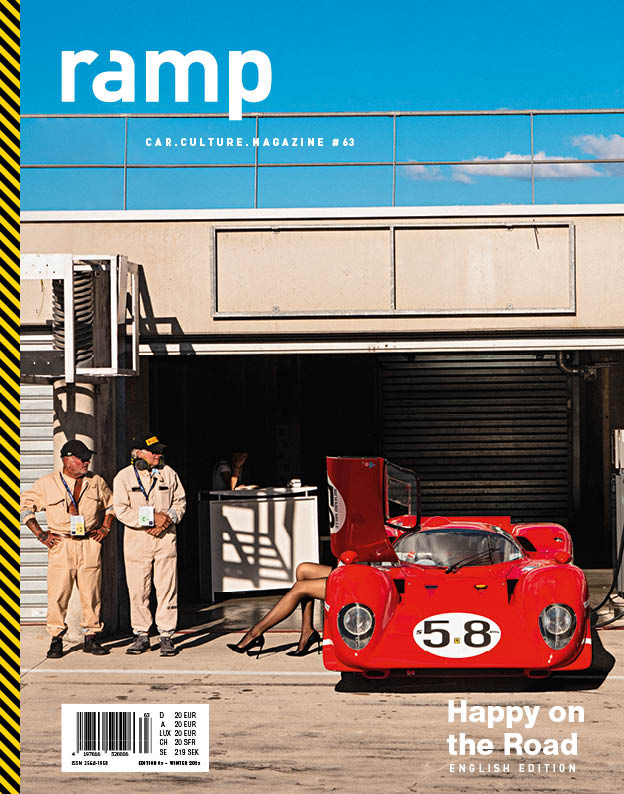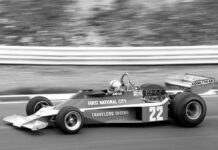Anticipation, excitement, relaxation. Epic Drive is what Mazda calls its road trip through Iceland with the MX-30 e-Skyactiv R-EV.
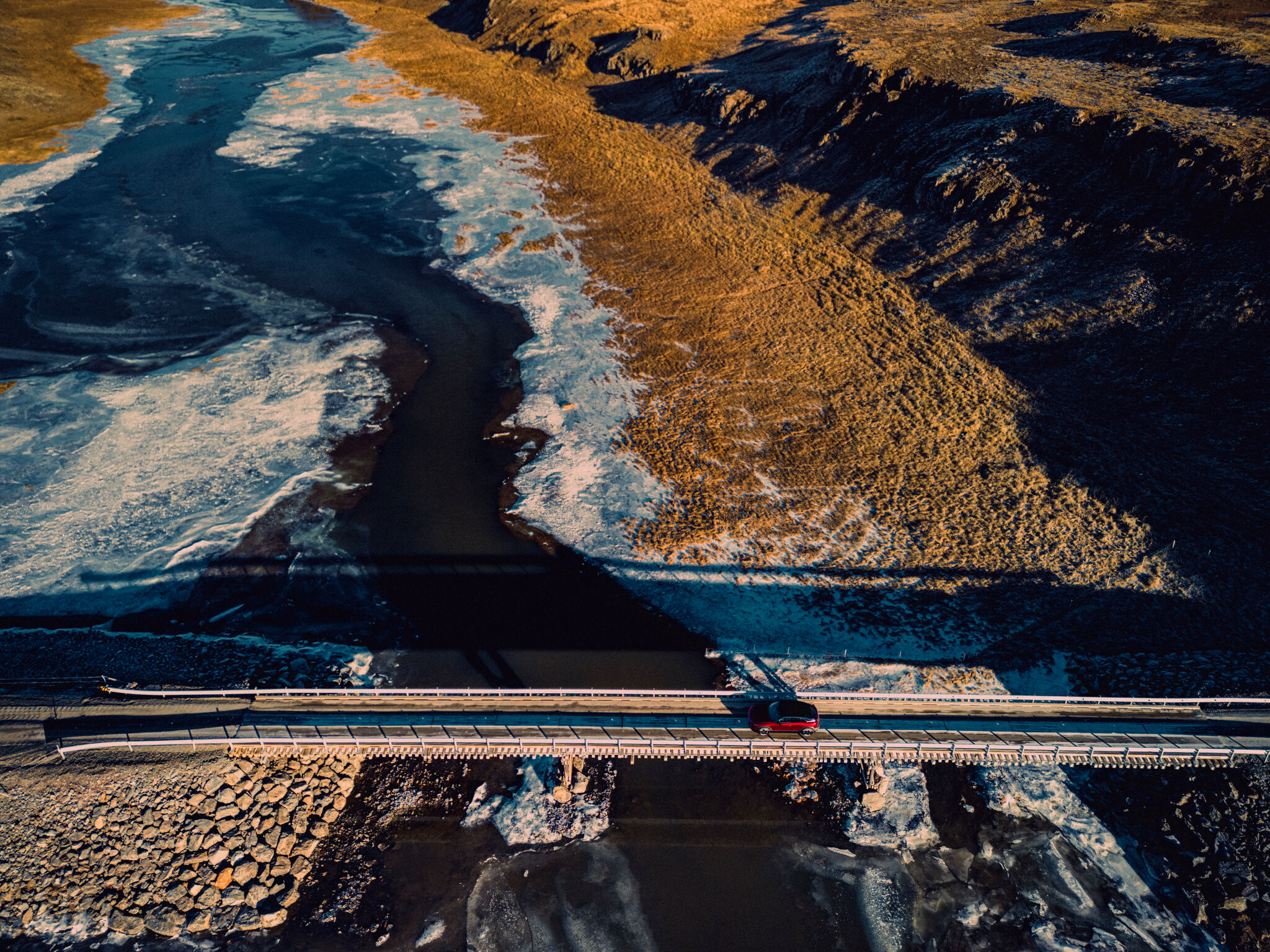
Rarely has the level of excitement and anxiety before a test drive been as great as this time with the new Mazda MX-30 e-Skyactiv R-EV. A few headlines shortly before our departure: “Threat of volcanic eruption in Iceland”, “Iceland ‘on the edge’”, “When will the Iceland volcano erupt?”, “Grindavík a ghost town as earthquakes spark evacuation”.
Mazda called this adventure an “Epic Drive”. In retrospect, we can say that things stayed quiet. And that goes for both the Mazda as well as the volcano. But first things first.
“I once got a drawing from a young boy of an electric car powered by small wind turbines on the roof. A nice idea, it shows creativity, but we’ll probably never actually try it out.” Christian Schultze, Director of Research & Operations at Mazda Motor Europe, shares this story with a group of journalists in Iceland during his presentation of the new Mazda MX-30 e-Skyactiv R-EV. Schultze has spent nearly thirty years working on innovations in automotive engineering. He is driven by the realization that the car is a product of the twentieth century – but how exactly it will fit into the twenty-first, that is a question to which Schultze is seeking an answer. And it is one of the reasons why Mazda has organized its Iceland Epic Drive.

The road trip was originally scheduled to head for Grindavík to visit the nearby Svartsengi geothermal power plant, where Schultze and Mazda see exciting things happening in the field of alternative fuels such as e-methanol. Svartsengi is the world’s first power station to use carbon dioxide on an industrial scale to produce methanol, which is primarily intended for use as a fuel in shipping. That also produces CO2, but significantly less than would result from burning gasoline, diesel or heavy fuel oil. Unfortunately, the itinerary had to be changed because this is exactly where the Craters of Laki are located. Only 250 meters below the earth’s surface, the temperature already reaches 200 °C. Magma is currently pushing its way to the surface here, accompanied by over eight hundred earthquakes in recent days. The earth is seething. And it does so constantly. When things are calmer, people go swimming here in the Blue Lagoon, but now the authorities have had to evacuate the area. Experts are expecting Iceland’s fourth volcanic eruption within a span of just three years. Twenty million years ago, our earth looked exactly the same geologically as it does today. With just one important difference. There was only water. But then came Iceland. Erupting from the depths. And this geological party is far from over. In the Middle Ages, people thought Iceland was the entrance to hell. It was only two hundred years ago – a mere blip in geological terms – that the Lakagígar volcanic fissure burst open over a length of around twenty-five kilometers. More than a hundred and thirty vents spewed lava, and toxic ash rained down over the entire country. To this day, sandstorms of biblical proportions whip across the island, volcanoes erupt beneath glaciers, and tidal waves, like those in a Roland Emmerich blockbuster, roll over everything here for real, tearing away roads and bridges and changing the landscape within a matter of hours. Time and time again. Even today, none of the geologists can explain exactly how and why such a huge eruption could occur at such a late stage in the earth’s development. You can literally watch this land being formed.

Christian Schultze smiles when he is asked about all the innovations that have been packed into the Mazda MX-30 e-Skyactiv R-EV. He is prepared, of course, and it is in almost ceremonious fashion that he says: “Let’s talk about the Wankel engine.” And so, time for a little digression from the archives: The Wankel engine, a rotary engine invented by German engineer Felix Wankel, can be described without hesitation as a genuine innovation in the field of engine design. Wankel conducted his first experiments in the early 1930s. Twenty years later he was commissioned by German firm NSU Motorenwerke to continue his research, although it was Hanns-Dieter Paschke who came up with a feasible concept behind Wankel’s back. When Wankel got wind of this, he was less than pleased: “You’ve turned my racehorse into a plough mare.” The remark is considered legendary today, as is the terse reply from NSU CEO Gerd Stieler von Heydekampf: “If at least we already had the mare.”
The rotary design, with its quiet operation, manageable size and fuel economy, proved to be quite a success, however, with millions of units sold. Mazda first presented a rotary concept at the Tokyo Motor Show in 1964, and in 1967 the company began production of its first rotary-engine car. The Japanese automaker even won the 24 Hours of Le Mans in 1991 with a Wankel-powered 787B prototype.
Felix Wankel passed away in 1988. The most memorable rotary-engine car in production was the exotic RX-8, but the MX-30 e-Skyactiv R-EV is a world away from that. Nevertheless, the doors opening in opposite directions can be seen as a nod to the RX-8. And things are quiet behind the wheel of this Mazda. Relaxed and calm. The journey takes us along the west coast of the island on a rural road that has been partly cut into the rock, right through the middle of a wild lava field of bizarre basalt structures. The Americans used to test their lunar vehicles here. Holes, fissures, crevices, bulges, mineral-like hills, cone-shaped volcanoes in the distance, snow-covered peaks, somewhere there is always steam coming out of the ground, the air is thick with the stench of sulfur. The light is refracted into a thousand fragments by the sea. The rain turns into a light, lingering haze. And then the sky clears – in the space of just a few moments
Speaking of clarity: What exactly is so innovative about the Mazda MX-30 e-Skyactiv R-EV? Things are bound to get technical at this point. The powertrain is officially a plug-in hybrid, with the gasoline-burning rotary engine acting as a generator to produce the electricity to power the wheels. This Wankel is a completely new development, with the displacement of a serious motorcycle (830 cc) and numerous measures to reduce friction loss. On top of it all, the engine features an exhaust gas recirculation system to increase performance. All in all, everything is efficient, clean and so compact that it fits into the body of the all-electric MX-30.
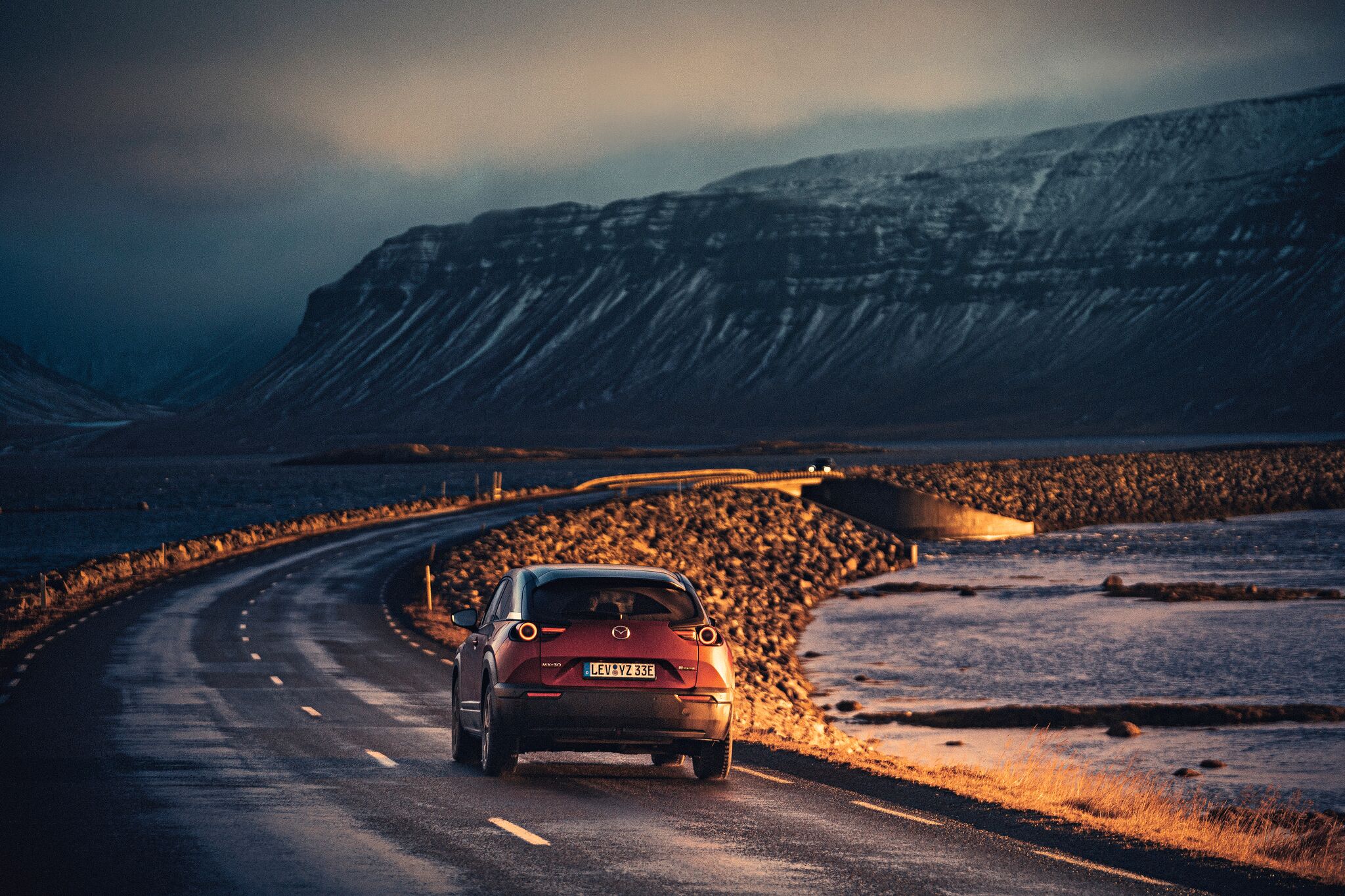
We head north. The snow comes drifting up from all directions, then the fog rolls in. The longer you drive through Iceland, the more you doubt that you’re actually still on Planet Earth. A gas station, the last one for the next one hundred and fifty kilometers, brings us back to reality. If you believe the statistics published by the Air Force and the Navy, there were a total of 385 airplane crashes over Iceland between 1941 and 1973. That’s an average of one every thirty-one days. This is all the more remarkable given the fact that there was never a war in or around Iceland during this time – not to mention that the country doesn’t even have a standing army of its own. Instead of paying for the wreckage to be removed after a crash, the U.S. military reached an agreement with sparsely populated Iceland that the remains of an aircraft would simply be left on site and the military would salvage whatever it considered usable. The most famous wreck is a Douglas C-117 on the beach at Sólheimasandur. Wingless, a skeleton riddled with bullet holes that has become a minor celebrity on social media. Hundreds of thousands of tourists make a pilgrimage to the black lava beach every year just to take a picture.
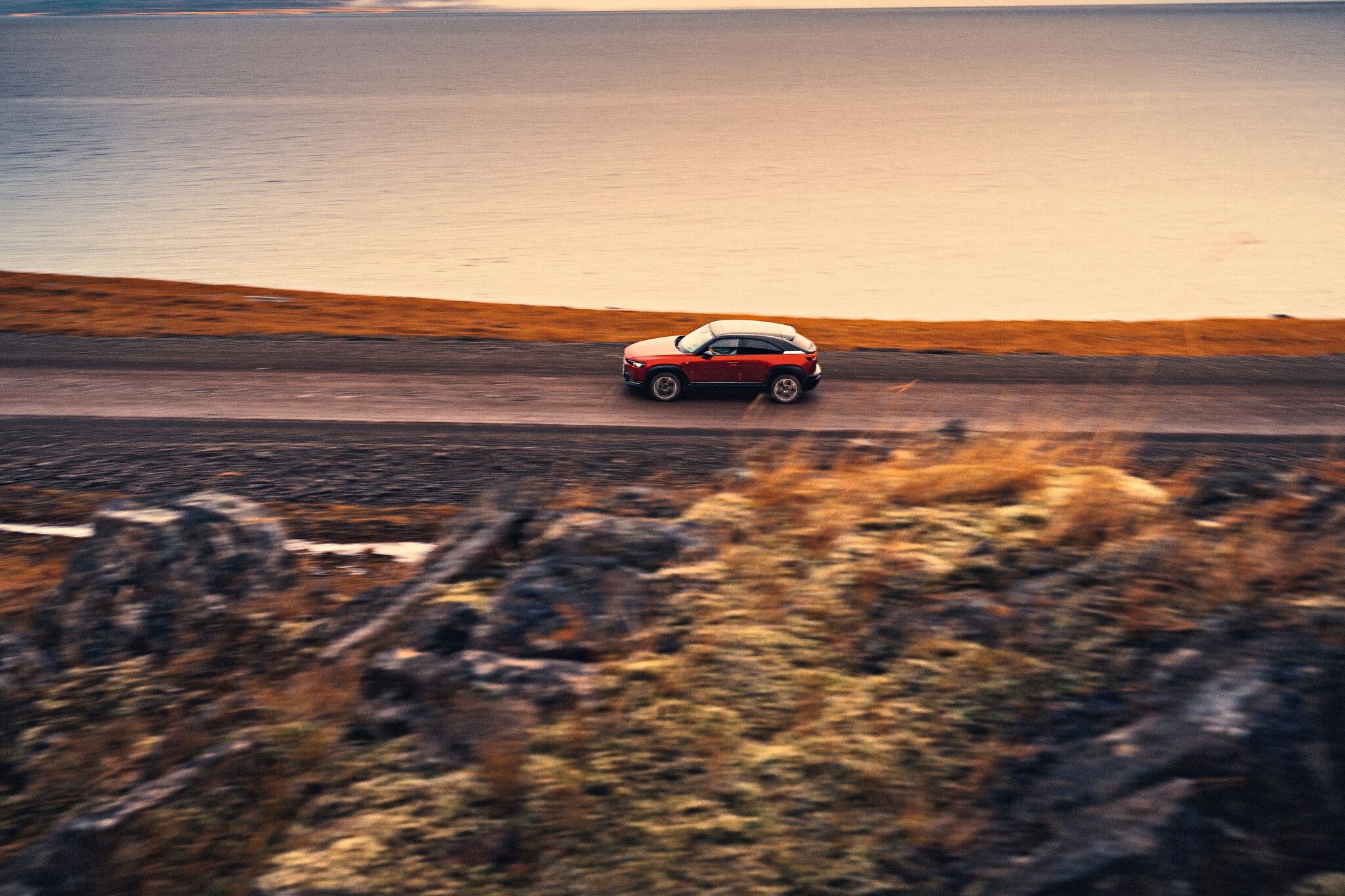
We’ve been on the road for over five hundred kilometers. The range is not a problem. The MX-30 can manage up to eighty-five kilometers all electric, with a total range of around six hundred and fifty. If you set the driving mode to Charge, you can specify a minimum battery level. Driving through Iceland in a Wankel plug-in hybrid – now that’s an idea you don’t come up with every day. Not at all mainstream. On the other hand, it wouldn’t be very epic to try and cover the whole island in an MX-30. Iceland is simply too unforgiving for that.
Text & Photos: Matthias Mederer · ramp.pictures
ramp #63 Happy on the Road
